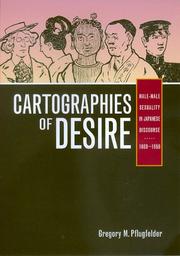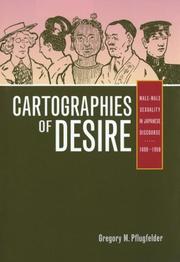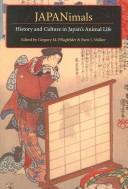| Listing 1 - 5 of 5 |
Sort by
|

ISBN: 0520209095 Year: 1999 Publisher: Berkeley University of California Press
Abstract | Keywords | Export | Availability | Bookmark
 Loading...
Loading...Choose an application
- Reference Manager
- EndNote
- RefWorks (Direct export to RefWorks)
In this sweeping study of the mapping and remapping of male-male sexuality over four centuries of Japanese history, Gregory Pflugfelder explores the languages of medicine, law, and popular culture from the seventeenth century through the American Occupation. Pflugfelder opens with fascinating speculations about how an Edo translator might grapple with a twentieth-century text on homosexuality, then turns to law, literature, newspaper articles, medical tracts, and other sources to discover Japanese attitudes toward sexuality over the centuries. During each of three major eras, he argues, one field dominated discourse on male-male sexual relations: popular culture in the Edo period (1600-1868), jurisprudence in the Meiji period (1868-1912), and medicine in the twentieth century. This multidisciplinary and theoretically engaged analysis will interest not only students and scholars of Japan but also readers of gay studies, literary studies, gender studies, and cultural studies.
J4172 --- J4127 --- J5920 --- Homosexuality --- -Homosexuality and literature --- -Homosexuality in literature --- Legal literature --- -Love in literature --- Medical literature --- -Life sciences literature --- Medicine --- Law books --- Lawbooks --- Law --- Literature and homosexuality --- Literature --- Same-sex attraction --- Sexual orientation --- Bisexuality --- Japan: Sociology and anthropology -- family and interpersonal relations -- sex relations (identity, preference, community, customs and culture) --- Japan: Sociology and anthropology -- social identity and self --- Japan: Literature -- premodern fiction and prose ( -1868) --- History --- History and criticism --- Homosexuality and literature --- Homosexuality in literature. --- Love in literature. --- History. --- History and criticism. --- -Japan: Sociology and anthropology -- family and interpersonal relations -- sex relations (identity, preference, community, customs and culture) --- -Law books --- Homosexuality in literature --- Love in literature --- Life sciences literature --- J4176.10 --- J4260 --- Japan: Sociology and anthropology -- gender roles, women, feminism -- policy, legislation, guidelines, codes of behavior --- Japan: Sociology and anthropology -- penology

ISBN: 9780520251656 Year: 1999 Publisher: Berkeley ; London : University of California Press,
Abstract | Keywords | Export | Availability | Bookmark
 Loading...
Loading...Choose an application
- Reference Manager
- EndNote
- RefWorks (Direct export to RefWorks)
Homosexuality --- Homosexuality and literature --- Legal literature --- Medical literature --- Love in literature. --- Homosexuality in literature. --- Homosexualité --- Homosexualité et littérature --- Droit --- Médecine --- Amour dans la littérature --- Homosexualité dans la littérature --- History. --- History --- History --- Histoire --- Documentation --- Histoire --- Documentation --- Histoire

ISBN: 1929280300 1929280319 Year: 2005 Publisher: Ann Arbor University of Michigan. Center for Japanese studies
Abstract | Keywords | Export | Availability | Bookmark
 Loading...
Loading...Choose an application
- Reference Manager
- EndNote
- RefWorks (Direct export to RefWorks)
Animals --- Human-animal relationships --- History. --- J6008 --- J6030 --- Japan: Art and antiquities -- history --- Japan: Art and antiquities -- themes, symbolism and iconography --- Animal kingdom --- Beasts --- Fauna --- Native animals --- Native fauna --- Wild animals --- Wildlife --- Organisms --- Zoology --- Animal-human relationships --- Animal-man relationships --- Animals and humans --- Human beings and animals --- Man-animal relationships --- Relationships, Human-animal --- History --- Japan
Book

ISBN: 0824882652 0824882636 Year: 2020 Publisher: Honolulu : University of Hawaii Press,
Abstract | Keywords | Export | Availability | Bookmark
 Loading...
Loading...Choose an application
- Reference Manager
- EndNote
- RefWorks (Direct export to RefWorks)
This is the first of a three-volume anthology of Edo- and Meiji-era urban literature that includes An Edo Anthology: Literature from Japan's Mega-City, 1750-1850 and A Tokyo Anthology: Literature from Japan's Modern Metropolis, 1850-1920. The present work focuses on the years in which bourgeois culture first emerged in Japan, telling the story of the rising commoner arts of Kamigata, or the "Upper Regions" of Kyoto and Osaka, which harkened back to the Japan's middle ages even as they rebelled against and competed with that earlier era. Both cities prided themselves on being models and trendsetters in all cultural matters, whether arts, crafts, books, or food. The volume also shows how elements of popular arts that germinated during this period ripened into the full-blown consumer culture of late-Edo. The tendency to imagine Japan's modernity as a creation of Western influence since the mid-nineteenth century is still strong, particularly outside Japan studies. A Kamigata Anthology challenges such assumptions by illustrating the flourishing phenomenon of Japan's movement into its own modernity through a selection of the best examples from the period, including popular genres such as haikai poetry, handmade picture scrolls, travel guidebooks, kabuki and joruri plays, prose narratives of contemporary life, and jokes told by professional entertainers. Well illustrated with prints from popular books of the time and artwork containing poems and commentaries, the volume emphasizes texts currently unavailable in English and translated into entertaining, vibrant prose.
Multi

ISBN: 9780824882631 Year: 2020 Publisher: Honolulu
Abstract | Keywords | Export | Availability | Bookmark
 Loading...
Loading...Choose an application
- Reference Manager
- EndNote
- RefWorks (Direct export to RefWorks)
This is the first of a three-volume anthology of Edo- and Meiji-era urban literature that includes An Edo Anthology: Literature from Japan's Mega-City, 1750-1850 and A Tokyo Anthology: Literature from Japan's Modern Metropolis, 1850-1920. The present work focuses on the years in which bourgeois culture first emerged in Japan, telling the story of the rising commoner arts of Kamigata, or the "Upper Regions" of Kyoto and Osaka, which harkened back to Japan's middle ages even as they rebelled against and competed with that earlier era. Both cities prided themselves on being models and trendsetters in all cultural matters, whether arts, crafts, books, or food. The volume also shows how elements of popular arts that germinated during this period ripened into the full-blown consumer culture of the late-Edo period. The tendency to imagine Japan's modernity as a creation of Western influence since the mid-nineteenth century is still strong, particularly outside Japan studies. A Kamigata Anthology challenges such assumptions by illustrating the flourishing phenomenon of Japan's movement into its own modernity through a selection of the best examples from the period, including popular genres such as haikai poetry, handmade picture scrolls, travel guidebooks, kabuki and joruri plays, prose narratives of contemporary life, and jokes told by professional entertainers. Well illustrated with prints from popular books of the time and hand scrolls and standing screens containing poems and commentaries, the entertaining and vibrant translations put a spotlight on texts currently unavailable in English.
| Listing 1 - 5 of 5 |
Sort by
|

 Search
Search Feedback
Feedback About UniCat
About UniCat  Help
Help News
News